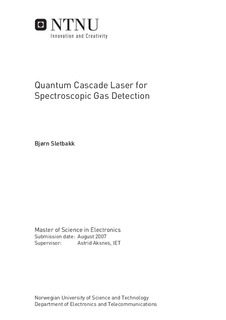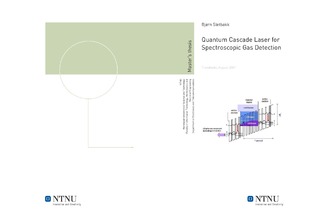| dc.description.abstract | In this project it has been focused on the use of a 7.42 um, 4 mW Quantum Cascade Laser in trace gas detection spectroscopy. Norsk Elektro Optikk (NEO) is in possession of a Nanoplus G2102/DFB2/5-12 QCL laser, that can be used in spectroscopic detection of H2O, CO2 and SO2 It has been attempted to construct a setup that can be used for spectroscopic measurements using a self constructed current driver module to produce current pulses for the QCL. The QCL is operated in pulsed mode, with pulses of <500 ns width, and a 1 kHz pulse repetition frequency. Temperature control of the laser has been conducted with a LaserGas II SP monitor module, and temperature has been kept at 280 K during testing. Initially, various test have been conducted to ensure the general functionality of the driver module, and to avoid damage to the QCL. Two different solutions for the transmission line from the driver to the QCL have also been examined, and it has been concluded that the current pulses supplied to the laser are of good quality with minor broadening and short rise/fall times. Furthermore an I-V characteristic for the laser has been produced by incrementing the laser driving current, and measuring the corresponding laser voltage. Measurements of the laser output power have been conducted using a CaF2 collimating lens to focus the laser beam onto a PVI-2TE-8 Vigo photovoltaic detector from Vigo Systems S.A. It has proved difficult to obtain a good signal from the detector, with the maximum voltage measured across a 50Ω shunt resistor being 3 mV. This is 100-200 mV less than what should be expected. Various methods of noise reduction have been applied to improve the detected signal, none have however provided any noticeable improvements. Several possible reasons for the generally low output have been examined. | nb_NO |

